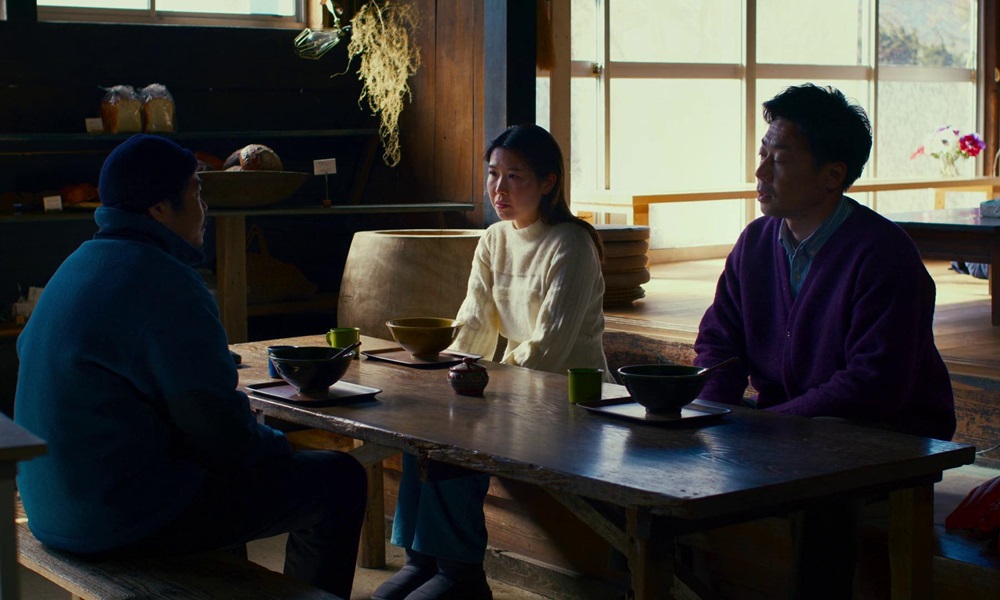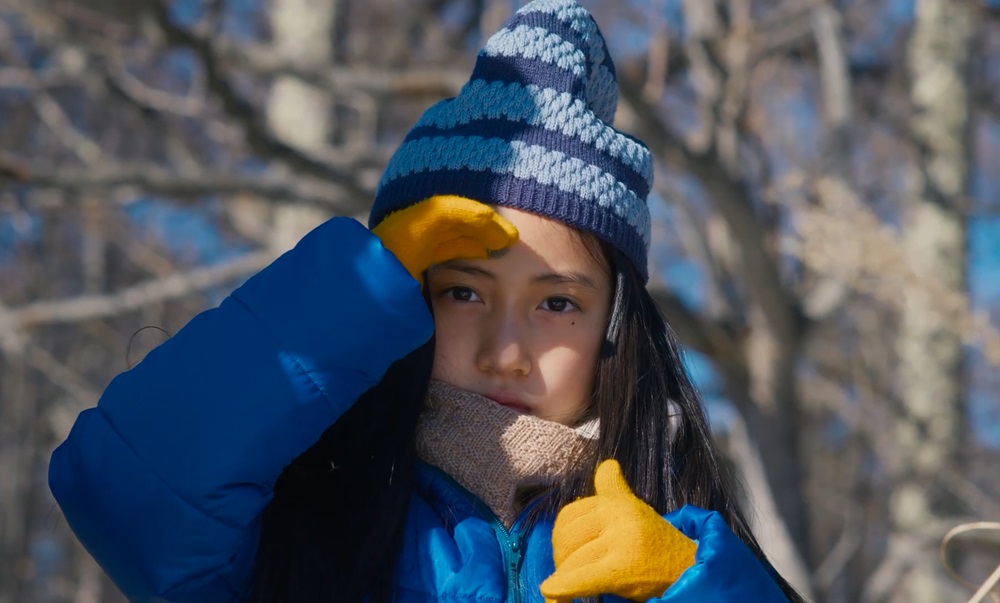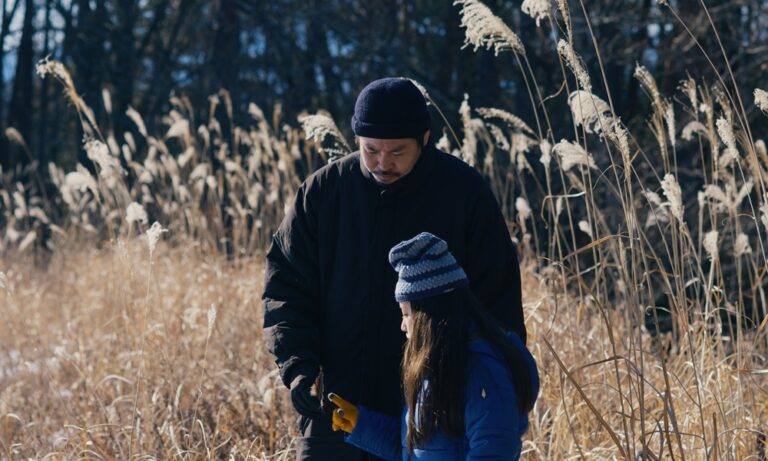What unfolds is a slow-burn meditation on humanity’s fragile relationship with nature—an exquisite yet haunting film that explores themes of harmony, empathy, and the cost of progress. And while it doesn’t quite reach the heights of “Drive My Car,” “Evil Does Not Exist” nonetheless prides itself on deeper introspection that may not have the same sweeping scope but is no less ambitious.
The film takes place in Mizubiki, a rural mountain village on the outskirts of Tokyo. Nestled in a snow-covered forest, the village is home to residents who live in quiet symbiosis with the natural world. We meet Takumi (Hitoshi Omika), a widower and odd-jobs man, who spends his days chopping firewood, gathering spring water, and caring for his eight-year-old daughter, Hana (Ryo Nishikawa).
Hamaguchi doesn’t portray his protagonist as an idealized figure; on the contrary, Takumi is forgetful, occasionally absentminded, and smokes like there’s no tomorrow. Nonetheless, he embodies a kind of lived harmony with his surroundings. His world is one of small pleasures: the scent of wild wasabi leaves, the warmth of a well-stoked fire, and the joy of seeing Hana trudge through the forest, unbothered by the cold.
Upending a Village’s Connection to Their Environment
The plot thickens when two corporate representatives, Takahashi (Ryuji Kosaka) and Mayuzumi (Ayaka Shibutani), arrive in the village. The company they represent plans to develop a glamping site meant to attract city dwellers looking for a taste of rural life. Their mission seems simple: pitch the idea to the villagers, secure their approval, and get the project off the ground.
However, things don’t go as smoothly as the two expect. During the community meeting, Takumi and the villagers politely but firmly dismantle the proposal. For one, they fear that the septic tank design for the resort could contaminate their water supply, a vital resource that sustains the local udon restaurant and nourishes their sense of place. Others worry about the risk of wildfires, which could easily spread from unsupervised campfires. By filming this scene with gripping realism, Hamaguchi touches upon the depth of the villagers’ connection to their environment. This bond is rooted not in nostalgia but in the practical realities of survival.
What makes the film compelling is that the filmmaker refuses to depict the corporate representatives as villains. Takahashi and Mayuzumi are not cynical manipulators but rather hapless employees caught in a system they barely believe in. As they share awkward, halting conversations in their car, we glimpse their personal disillusionment: Takahashi dreams of escaping his corporate life, while Mayuzumi feels unmoored, confessing that she feels “dysfunctional” in her soul. The humor in their clumsy attempts to bond with the villagers, such as Takahashi’s poor efforts at chopping firewood, adds unexpected warmth to the story.

Hamaguchi’s Penchant for Deliberate Pacing and Subtle Emotional Shifts
Hamaguchi’s films are known for their patient storytelling, and this latest outing is no exception. “Evil Does Not Exist” feels like a natural extension of Hamaguchi’s previous work, notably “Wheel of Fortune and Fantasy” and the aforementioned “Drive My Car.” The movie builds on the director’s predilection for capturing the quiet beauty of everyday life—finding meaning in conversations, gestures, and moments of stillness. Hamaguchi’s signature use of long takes allows viewers to sit with the characters and their emotions, fostering a sense of intimacy that feels both engrossing and meditative.
The filmmaker also has a gift for revealing the complexity of human interaction through subtle emotional shifts. Here, the interactions between the villagers and the corporate representatives evolve gradually, with humor and tension emerging organically. Takumi’s relationship with both Takahashi and Mayuzumi highlights Hamaguchi’s ability to craft nuanced character dynamics. Though these city-dwellers initially arrive with an air of detachment, they soon find themselves drawn into the slower rhythms of village life.
Yet, even Hamaguchi’s most ardent supporters may find the abrupt tonal shift in the final act jarring, with the lack of clear resolution leaving some unsatisfied. In Hamaguchi’s defense, though, here’s why I think it works: The director doesn’t seem too interested in neat endings or easy answers. Instead, he encourages us to sit with discomfort and consider what it means to coexist with both natural and societal forces that are beyond our control.
The Rise of Eco-Parables in Contemporary Cinema
Hamaguchi’s film also reflects a growing trend in contemporary cinema: the rise of eco-fiction and eco-parables. In an era defined by climate anxiety, environmental degradation, and the exploitation of natural resources, more filmmakers are turning to narratives that examine humanity’s relationship with the planet.
Films like Kelly Reichardt’s “First Cow” or Apichatpong Weerasethakul’s “Memoria” offer quiet reflections on how nature shapes human life, while more overt eco-fiction works, such as Bong Joon-ho’s “Okja,” tackle environmental issues head-on. These stories reflect a collective grappling with the tension between progress and preservation, development and conservation.
“Evil Does Not Exist” is a worthy addition to this growing canon, though it approaches its ecological themes with a more understated hand. Rather than issue warnings or declarations, the film immerses viewers in the quotidian lives of people who are acutely aware of their dependence on nature. The villagers understand that their survival is tied to their environment, not just as a resource but as something that sustains their sense of community and identity. This intimate portrayal of ecological awareness, communicated through small actions and conversations, makes the film’s message all the more potent.
One of the reasons “Evil Does Not Exist” resonates with me so deeply is that it doesn’t try to preach or deliver grand moral statements. Instead, it exhorts viewers to reflect on what it means to live in balance, both with the natural world and with each other. The film suggests that interference, whether from corporate development or human ambition, has consequences that may be subtle at first but accumulate over time. Even Takahashi and Mayuzumi’s personal transformations—their growing empathy toward the villagers—cannot undo the damage their project has already set in motion.

Eco-Parable as Emotional Provocation
The film’s ambiguous title, “Evil Does Not Exist,” reinforces this idea. On the surface, Hamaguchi seems to suggest a world where individuals are neither good nor evil but simply trying to navigate their lives. The villagers’ resistance to the glamping site is not born out of malice, and the corporate duo, though misguided, are not irredeemable. Yet the film quietly asks: Is harmony with nature ever truly achievable? Or is it always an illusion, slipping away the moment ambition, greed, or neglect enters the picture?
The symbolism throughout the film deepens these questions. We see images of animal tracks in the snow, skeletal remains, and a wounded deer; each hinting at the idea that nature, while beautiful, is also brutal and indifferent. Takumi’s life may seem idyllic, but the landscape around him carries a quiet menace. As Takumi warns Takahashi, a gut-shot deer will attack if cornered, just as nature itself may lash out when disturbed by human interference.
Hamaguchi leaves those questions open, trusting his audience to sit with the discomfort of uncertainty. This is where the film’s power lies: not in offering solutions but in forcing viewers to confront the fragile equilibrium that underpins both natural and human systems. The film’s ending, with its abrupt tonal shift, serves as a final reminder that nature’s harmony is not something we can take for granted. It is a fleeting state, easily unsettled and not always recoverable.
‘Evil Does Not Exist’: A Quiet but Resonant Masterwork
Visually, Kitagawa’s camerawork captures both the beauty and menace of the winter forest. Long, unbroken shots of tree branches against a pale sky evoke a sense of stillness, while the sounds of footsteps in the snow or a hunter’s distant rifle remind us of the latent danger that exists beneath the surface. Ishibashi’s score, with its sudden silences and abrupt shifts, mirrors the film’s emotional landscape—calm one moment, ominous the next.
This interplay between visuals and sound captures beauty and dread, complementing Hamaguchi’s direction; depicting the precarious balance between humanity and nature and showing how quickly things can unravel. In the film, the very idea of progress, no matter how well-intentioned, upsets the equilibrium of the village. This sense of unease culminates in an ending that is as enigmatic as it is powerful. Without revealing too much, the final act reorients the entire film, leaving audiences to wonder whether the harmony they witnessed was ever real or just a fleeting moment before another inevitable disturbance.
“Evil Does Not Exist” is a film that rewards those willing to engage with its understated storytelling. It may not have the narrative clarity or emotional immediacy of “Drive My Car,” but it offers something equally profound: a reflection on the delicate balance between progress and preservation, empathy and ambition, harmony and disruption.
As an exquisitely crafted work, it rewards patience with insight, humor with melancholy, and uncertainty with depth. In a way, Hamaguchi invites us to ask quietly but insistently, “If evil does not exist, what does?”

“Evil Does Not Exist” premiered at the 80th Venice International Film Festival. It had its theatrical release in the US on 3 May 2024 by Sideshow/Janus Films.


